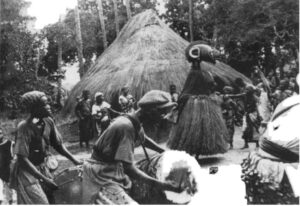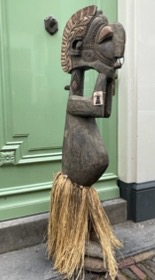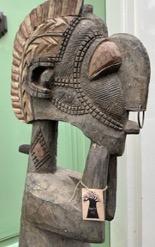What is the purpose of the Baga Nimba mask?
This ritual mask represents the embodiment of the ideal fertile woman. Thus, it is not seen as a fertility “spirit,” but as an idea of the woman and the ideal image of her role in the Baga community: a mother figure. In its original ritual context, the mask was used in a ceremonial dance during harvest and symbolizes fertility and life. Today, the Nimba can be found in museums, such as the Louvre (Paris) and the Metropolitan Museum (New York), where they are valued mainly for their aesthetic qualities. Picasso also owned a Nimba in the 1920s. (1)
What do they look like?
A Baga Nimba mask is a large, wooden shoulder mask (120-130 cm) decorated with plant fibers and pigments. The plant fibers are placed so that they cover the wearer of the mask. The ears of the Nimba are often U-shaped (on its side). The face and breasts of the mask usually show patterns of facial scarification.
Just imagine how heavy it is to carry such a wooden mask on your shoulders. Sometimes they weigh as much as 60 kilograms! (2)

Ceremony with Nimba in 1938 (source: Béatrice Appia-Blacher, Musée du Quai Branly).
The Baga Nimbas at Rootz Gallery
A Nimba is usually seen as a shoulder mask, but occasionally as a stand-alone sculpture. At Rootz Gallery we have both versions! The shoulder mask is a female version (identified by the breasts) and the standing one is a male version (identified by the phallus). Man and woman were often (when not used during rituals) placed side by side at a place of worship.

Nimba shoulder mask (female), collection Rootz Gallery

Close-up Nimba shoulder mask (female), collection Rootz Gallery

Standing Nimba (male), collection Rootz Gallery

Close-up standing Nimba (male), collection Rootz Gallery
1. William Rubin, “Primitivism” in 20th Century Art: Affinity of the Tribal and the Modern (New York: Museum of Modern Art, 1984), 325-326.
2. For more information, see: Iris Hahner, Maria Kecskési en László Vajda, African Masks: The Barbier-Mueller Collection (München: Prestel Publishing, 2010).
